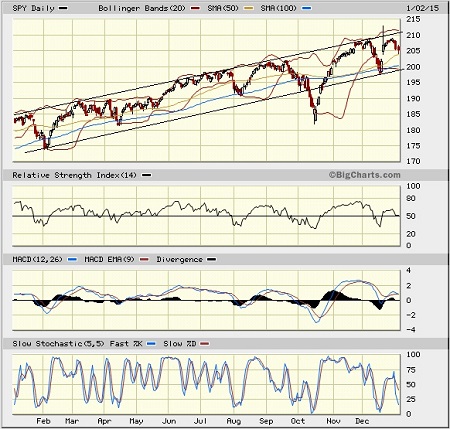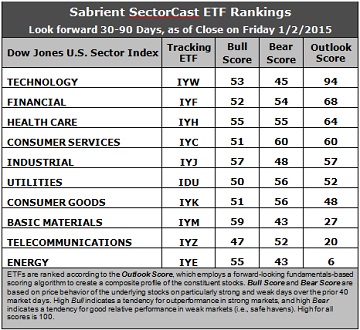Another solid year for U.S. equities came to a close. But it’s not like everyone is jumping up and down with enthusiasm, which is a good thing. With plenty of bogeymen in the closet and under the bed, there is little in the way of irrational exuberance. Although some commentators noted that 2014 finished up much the same as 2013, there was really quite a bit of difference between the past two years, primarily in the way of lower correlations in 2014 as opposed to the all-boats-lifted environment of 2013.
Looking ahead, 2015 looks promising for further gains, but not without bouts of volatility. In fact, it might look a lot like 2014. In this weekly update, I give my view of the current market environment, offer a technical analysis of the S&P 500 chart, review our weekly fundamentals-based SectorCast rankings of the ten U.S. business sectors, and then offer up some actionable trading ideas, including a sector rotation strategy using ETFs and an enhanced version using top-ranked stocks from the top-ranked sectors.
Market overview:
As we see the close to yet another successful year for the U.S. stock market, we can look back on 2014 and recall the many bogeymen that caused investor consternation. There was the end of the Fed’s tapering of QE3 (although maturing securities are still being reinvested rather than retired). There was the huge collapse in Crude Oil prices (and still falling today), causing major disruptions in global markets. Then of course we had the slowdowns in China, Japan, and Europe -- and Greece is again in crisis mode.
There was major turmoil in Russia and the Ukraine. We witnessed the sudden emergence of ISIS as a terrorist organization with its own army (and social media savvy). There was the fear of Ebola spreading into a global epidemic. And here at home, we had the uncertainty surrounding implementation of Obamacare, as well as the mid-term elections putting the GOP in control of both houses of congress. Did I miss anything?
The Dow Jones Industrials blue chips, the S&P 500 large cap index, and the NASDAQ ended the year up about +7.5%, +11.3%, and +17.4% respectively, while the S&P Midcap 400 gained about +8% and the Russell 2000 small cap index gained only +3.7%. The Russell 2000 made an attempt to break out above strong resistance at 1200, but ultimately failed. The NASDAQ at one point looked ready to challenge the 5,000 level for the first time in nearly 15 years, but couldn’t gather enough bullish conviction before the year ended. The MSCI emerging markets index finished down -6%. Defensive strategies like low volatility and dividend yield outperformed in a general flight to quality.
Still, with leadership from large caps and defensive strategies, total capital in U.S. ETFs surpassed the $2 trillion mark. In addition, fixed income indexes rose in 2014 as long-dated yields continued to decline despite the Fed’s tapering of its quantitative easing (bond buying).
Among the ten U.S. business sectors, the top performers for the year were Utilities (+25%), Healthcare (+24%), and Technology (+19%), and all spent a lot of time during the year near the top of Sabrient’s forward-looking fundamentals-based SectorCast rankings. The worst performer by far was Energy, which is not surprising given the 50% haircut in oil prices. Also showing lackluster performance were Telecom and Basic Materials, which both spent a lot of time at the bottom of our sector rankings. Consumer Discretionary and Financial both showed good late year outperformance to make up some ground.
Economic reports continue to impress, at least domestically. Redbook weekly retail sales report showed a robust +5.4% year-over-year increase. Consumer confidence rose from 88.7 to 92.6, which is quite strong. Also, U.S. manufacturing activity continues to expand despite the struggles of overseas economies.
Leading economic indicators are strong, job growth is the strongest since the ‘90s, and corporate profits sit at all-time highs. Strong GDP growth is expected to continue into 2015 and beyond, which should propel equities to new heights, although the future for long-term bond prices is not as clear. Although the near-term will likely provide further flattening in the yield curve, eventually economic health will demand higher long-term rates and a steeper yield curve.
The IPO market last year was the busiest since 2000, and the Healthcare sector was buoyed by FDA approval of the most new drugs in 18 years, including many high-priced drugs that address rare conditions and orphan diseases.
For several years, oil production has been climbing in the U.S. and Canada, and there has been a lot of recovery among oil fields in Iraq and elsewhere. In addition, rising demand in China and India and other developing nations have kept supply/demand in balance. But North American production kept climbing far beyond expert predictions, while slowing growth and/or recession in China, Japan, and Europe along with rising fuel efficiencies in the U.S. led to reduced demand.
With traders and speculators no longer willing to keep the price artificially high due to geopolitical concerns, oil prices plummeted quickly, plunging much further than anyone thought possible. Sell-side analysts covering the Energy sector began slashing earnings projections once it became clear that lower prices were likely here to stay.
But asset classes tend to overshoot in both directions, and I believe we will see oil stabilizing soon. Energy stocks are highly dependent on oil prices and might be dead money for the foreseeable future, but it is not a bad idea to begin accumulating them in long-term accounts, particularly those stocks paying a reasonable dividend with hedges in place.
And the toll-taker type companies with locked-in pricing (including pipeline MLPs), which were the proverbial babies thrown out with the bathwater, might be the best long-term accumulation targets of all. Although oil prices may decline further in the near term, they likely will return to a more normal trading range. And in any case, the overall impact is positive for virtually all other segments of the economy.
It is said that bull markets don’t die of old age but rather from euphoria (in which valuations get totally out of whack) or when the economy falls into recession. And there seems to be nothing that can prevent a strong 2015. However, there is no denying the cautious and often defensive behavior of investors -- as the little voice in the back of their heads tells them that something just doesn’t feel right about it all. Bu this is healthy skepticism that is helping to prevent an unhealthy euphoria (a.k.a., irrational exuberance).
The CBOE Market Volatility Index (VIX), a.k.a. fear gauge, closed Friday at 17.79, which is still well above the line of complacency at 15, but below the important 20 threshold that suggests real fear. It is indicating heightened volatility and some lingering investor worry going into the New Year.
The U.S. 10-Year Treasury yield closed at 2.11%, which is still quite low, indicating a continued flight to quality among global investors in spite of the Fed’s desire for a normalization of interest rates (i.e., higher fed funds rate and a steeper yield curve). Its 52-week range is 1.86-3.06. In addition, the US dollar continues to strengthen while the euro sinks to its lowest level since 2006 due to speculation that the ECB will soon begin a quantitative easing program by purchasing sovereign debt.
Any increase in interest rates here at home will serve to attract even more global capital into U.S. Treasuries. This keeps lending rates down here at home, helping boost the housing market, but it also further strengthens the dollar, which makes it harder for those countries with the weaker currencies to pay down their debt.
While many are expecting the Fed to begin raising rates nominally sometime in the middle of 2015, the FOMC has taken a more dovish turn with its latest voter rotation, so some observers actually are speculating that we won’t see a boost in rates until 2016. I think this scenario is entirely possible. But in any case, rates will not rise rapidly.
Of course, persistently low bond yields also serve to support higher P/E multiples in equities. The forward P/E on the S&P 500 is only about 16, and the spread between the S&P 500 earnings yield and the U.S. 10-Year yield is about 4% versus the historical norm of about 3%. Also, robust stock buybacks are likely to continue for a while at the prevailing ultra-low borrowing rates, which lowers the denominator in EPS and offsets new stock offerings and IPOs that typically serve to increase the denominator and dilute the overall profit pool. So, the market’s forward valuation is still quite reasonable -- particularly as corporate earnings continue to grow.
And with Q3 earnings season behind us and Q4 reports starting soon, sell-side analysts are anticipating EPS of $29.92 for the S&P 500 companies, which is an increase of +5.5% from Q4 2013, and total 2014 EPS growth is expected to come in at +7.5%, compared with +4.5% for 2013. This would be the best earnings growth since 2011’s +14.3%. Companies that generate real rising sales and earnings should outperform the speculative names, particularly in a global economy characterized by subdued demand and pricing pressures.
Yes, the U.S. is the main driver of global growth, while Europe slogs along, Japan slides into recession, and the BRIC countries appear to be destined for their slowest pace since emerging from the Great Recession. This performance gap between the U.S. and the rest of the world shows just how insulated we really are. Exports are just 14% of output, and big exporting countries like China, Germany, and Japan will be depending on us to help ignite their economies.
The New Year appears to be set to continue the path it set in 2014. The end of QE3 is allowing asset classes to perform according to their fundamentals rather than rewarding highly-correlated risk-on/risk-off behavior. Lower equity correlations, higher volatility, and a modest increase in U.S. equity prices are likely in 2015. As a result, some market experts are suggesting greater exposure to long/short, long-hedged, and market neutral equity strategies.
One choice in this regard is a recently-launched actively-managed ETF -- the First Trust Long Short ETF (FTLS), which employs as an input factor Sabrient’s Earnings Quality Rank (a.k.a., EQR), a pure accounting-based risk assessment signal based on the forensic accounting expertise of our subsidiary Gradient Analytics. We have found EQR quite valuable both for identifying short candidates and for helping to avoid higher-risk long positions.
As I predicted one year ago, 2014 ended up displaying a general flight to quality among investors in which the best companies with the most sustainable earnings growth and reasonable valuations got the most attention, while the speculative high-flyers that had been coat-tailing on bullish exuberance lost their luster. Sounds like rational investing. But this apparently made life for a lot of portfolio managers difficult. In fact, the Financial Times reported that only about 10% of stock pickers beat their benchmarks, and Morningstar reported that only about 13% of actively managed large-company mutual funds beat the S&P 500.
However, Sabrient’s annual Baker’s Dozen portfolio of 13 top picks finished its sixth straight strong year (since 2009 inception). It was up about +22% since its January 13 launch while the S&P 500 was up about +15% over the same timeframe. Top performers include Southwest Airlines (NYSE:LUV), NXP Semiconductors (NASDAQ:NXPI) NV, and Actavis plc (NYSE:ACT).
And going into 2015, as we finalize our new portfolio, the top of our forward-looking quantitative rankings once again reveals strength in airlines, semiconductors, and biopharma. Baker’s Dozen represents a sector-diversified group of stocks based on our Growth at a Reasonable Price (GARP) quant model and confirmed by a rigorous forensic accounting review by our subsidiary Gradient Analytics to help us avoid stocks at higher risk of issues that could result in a underperformance. It is packaged as a unit investment trust (UIT) by First Trust Portfolios (note: the new 2015 Baker’s Dozen portfolio will launch on January 14).
Looking ahead, companies that generate increasing sales and earnings will outperform, particularly in a global economy characterized by subdued demand and pricing pressures. Moreover, removing the Fed’s manipulation will eventually enable normalization to wider yield spreads, more profitable bank lending, increasing money supply, and robust economic growth.
SPY chart review:
The SPDR S&P 500 Trust (ARCA:SPY) closed last Friday at 205.43 after hitting a new 52-week high at the beginning of the week. I am still hopeful that the December technical pullback down to the lower trend line of the long-standing bullish rising channel was all the market needed in the way of a correction to avoid a more dramatic downside event in January, like the one we saw in Jan-Feb last year.
Oscillators RSI, MACD, and Slow Stochastic are all in a neutral position and could either cycle a bit further down to oversold territory or turn upward from here. The 50-day simple moving average, 100-day SMA, and lower trend line have each provided reliable support levels over the past year, and should continue to do so.
Only the October news-driven sell-off violated all of these support levels before recovering quickly in a V-bottom. Price closed Friday right at the 20-day SMA, and support follows at the 50-day near 204, the 100-day SMA near 201, and the lower trend line that is now approaching 200. There is a mid-December gap acting as a bit of a magnet that could take price down to about 201 to fill the gap, which would correspond with the 100-day SMA. Overhead resistance could arise at the 52-week highs and then the upper trend line that is now approaching 211.

Latest sector rankings:
Relative sector rankings are based on our proprietary SectorCast model, which builds a composite profile of each equity ETF based on bottom-up aggregate scoring of the constituent stocks. The Outlook Score employs a forward-looking, fundamentals-based multifactor algorithm considering forward valuation, historical and projected earnings growth, the dynamics of Wall Street analysts’ consensus earnings estimates and recent revisions (up or down), quality and sustainability of reported earnings (forensic accounting), and various return ratios. It helps us predict relative performance over the next 1-3 months.
In addition, SectorCast computes a Bull Score and Bear Score for each ETF based on recent price behavior of the constituent stocks on particularly strong and weak market days. High Bull score indicates that stocks within the ETF recently have tended toward relative outperformance when the market is strong, while a high Bear score indicates that stocks within the ETF have tended to hold up relatively well (i.e., safe havens) when the market is weak.
Outlook score is forward-looking while Bull and Bear are backward-looking. As a group, these three scores can be helpful for positioning a portfolio for a given set of anticipated market conditions. Of course, each ETF holds a unique portfolio of stocks and position weights, so the sectors represented will score differently depending upon which set of ETFs are used. We use the iShares that represent the ten major U.S. business sectors: Financial (NYSE:IYF), Technology (NYSE:IYW), Industrial (NYSE:IYJ), Healthcare (NYSE:IYH), Consumer Goods (NYSE:IYK), Consumer Services (NYSE:IYC), Energy (NYSE:IYE), Basic Materials (iShares US Basic Materials (NYSE:IYM), Telecommunications (NYSE:IYZ), and Utilities (NYSE:IDU). Whereas the Select Sector SPDRs only contain stocks from the S&P 500, I prefer the iShares for their larger universe and broader diversity. Fidelity also offers a group of sector ETFs with an even larger number of constituents in each.

